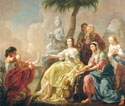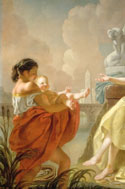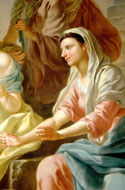Object Studies
Oil Painting

What Is This Object?
A painting, The Finding of the Infant Moses, made by Francis Hayman in 1746.
1The painting is a phyically large work, measuring 173.3 cm high by 203.4 cm wide (68¼ in. by 8011/16 in.).1 The image, a visual interpretation of Exodus 2:3–9, depicts a slave girl presenting Moses to Pharaoh's daughter. Pharaoh's daughter is supported by her attendants, who include Moses' sister and mother.2 In the background of the painting are a bridge and several Egyptian-style buildings and statues. Two vessels of an exotic or Egyptian style rest on the ground in the foreground.
The Finding of the Infant Moses was painted for Thomas Coram's Foundling Hospital in London and is now in the collection of the Foundling Museum. Web Link
^topHow Is the Color Made?
 The painting is executed on a plainweave canvas that was first nailed to a wood stretcher. reference The canvas was prepared by applying two separate layers of a gray-colored ground to the cloth. Both layers are made from a combination of lead white and chalk plus pigments identified as lamp black, ochers, and red lead. The proportion of medium used distinguishes the separate applications: The first layer is leaner than the second one. This follows a still-observed convention that each layer of an oil painting should contain more oil than those beneath it. A toning layer was then applied over the second layer of the ground. This layer modified the ground color, making it a more appropriate undercolor for Hayman's painting technique.3 It is probable that the canvas was prepared by a colorman or other supplier, as the Foundling Museum collection has another painting, from the same period but by another artist, with identical ground and toning layers.
The painting is executed on a plainweave canvas that was first nailed to a wood stretcher. reference The canvas was prepared by applying two separate layers of a gray-colored ground to the cloth. Both layers are made from a combination of lead white and chalk plus pigments identified as lamp black, ochers, and red lead. The proportion of medium used distinguishes the separate applications: The first layer is leaner than the second one. This follows a still-observed convention that each layer of an oil painting should contain more oil than those beneath it. A toning layer was then applied over the second layer of the ground. This layer modified the ground color, making it a more appropriate undercolor for Hayman's painting technique.3 It is probable that the canvas was prepared by a colorman or other supplier, as the Foundling Museum collection has another painting, from the same period but by another artist, with identical ground and toning layers.
In certain areas—for example, the flesh tones—Hayman added new color layers before the previous layer was fully dry, creating in essence a single paint layer rather than the multiple ones that result from more thorough drying between applications. Although the colors added in this wet-in-wet technique would retain most of the saturation of each color applied, the result is slightly less transparent. There are also a few details where the paint is applied more thickly: these areas of impasto include the bracelet of Pharaoh's daughter and in the metallic urn in the foreground.
5Hayman is known to have used mixtures of several pigments to create the colors in his paintings, occasionally employing different pigment combinations in each layer. The combinations of coloring materials were specific to the object rendered. So, while the draperies are principally made from red lake, the warmth of the flesh tones was achieved using vermilion, red lead, several earth colors, and black, all incorporated with lead white. The coloring material used to depict the dress of Pharaoh's daughter is probably Naples yellow with transparent sienna or other earth pigment added. Similarly, in creating green colors, Hayman used yellow, an opaque red, orange, blue, lead white, and black pigments to vary the color of his basic green earth. A paler green was made with the addition of chalk, as an extender, to the combination of lead white and earth pigments.
 The sky is composed of mixtures of vermilion, orange, white lead, and black and blue particles, often with a mixture of transparent and opaque pigments in the same layer, where the ground layer is covered with Prussian blue with some lead white. This is then covered with another layer of the same pigments in different proportions. The conservators who examined the painting noted the use of Prussian blue in combination with alum. reference This may have reflected an effort to control the instability of Prussian blue pigments in the presence of such alkalis as lead white. reference
The sky is composed of mixtures of vermilion, orange, white lead, and black and blue particles, often with a mixture of transparent and opaque pigments in the same layer, where the ground layer is covered with Prussian blue with some lead white. This is then covered with another layer of the same pigments in different proportions. The conservators who examined the painting noted the use of Prussian blue in combination with alum. reference This may have reflected an effort to control the instability of Prussian blue pigments in the presence of such alkalis as lead white. reference
 To create this painting, Hayman applied very thin layers of paint to the canvas, allowing each layer to dry or to dry partially before adding subsequent paint layers. The thinness of each layer enhances the transparency of the color; and they have an intensity that is partly due to the reflectance properties of the ground. An example of this technique is the red drapery of the slave girl, where the buildup of the layers adds to the impression of the weight and transparency of the fabric itself. Where separate layers are visible—for example, where a darker modeling color is applied over a lighter color—it is also clear that Hayman had allowed the paint to dry more thoroughly before adding the details.
To create this painting, Hayman applied very thin layers of paint to the canvas, allowing each layer to dry or to dry partially before adding subsequent paint layers. The thinness of each layer enhances the transparency of the color; and they have an intensity that is partly due to the reflectance properties of the ground. An example of this technique is the red drapery of the slave girl, where the buildup of the layers adds to the impression of the weight and transparency of the fabric itself. Where separate layers are visible—for example, where a darker modeling color is applied over a lighter color—it is also clear that Hayman had allowed the paint to dry more thoroughly before adding the details.
Condition
The Finding of the Infant Moses has been examined and cleaned several times since its completion. As a result, according to its most recent examiners, there is notable wear to the paint surface, and the painting lacks the colored glazes that were typical of eighteenth-century paintings.4 The conservators suggest that this may be due to the contemporary practice of applying those colors over a varnish; any color used in this way would have been lost with earlier cleaning or revarnishing treatments. They also noted areas, especially in the sky, where tiny craters formed in the paint as it dried, a surface characteristic that results from the excessive use of drying agents in the paint medium.5 This addition could be expected, given both the thinness of the paint layers and the desire for rapid drying: Over time, these craters have trapped dust and grime, giving portions of the painting an overall flat coloring and generally dirty appearance. There is considerable overpainting at the left edge, perhaps due to a formulation of Prussian blue that was not light-fast or to a color change caused by the mixture of Prussian blue with lead white. Over time, the lead white has dulled the color. reference
^topHow Is the Object Used?
Hayman painted The Finding of the Infant Moses as a donation to Thomas Coram's Foundling Hospital, at the request of his friend and colleague William Hogarth, a governor of the hospital.6 Hogarth had requested similar donations from other prominent artists, including Richard Wilson, Thomas Gainsborough, and Joseph Highmore. These contributions were displayed in a reception room at the hospital where, the governors hoped, their common subject—the welfare of children—would inspire benefactors. For Hayman, Hogarth, and several other donor-artists, commissions for further work can be traced to their contribution to the Foundling Hospital, and this may have been a reason these artists were willing to create and donate fairly large-sized works. Nevertheless, efficiencies of cost and time would have been necessary. The technique Hayman employed, with its minimal pigment and additional of drying agents, permitted a fairly rapid execution of the painting—completion in weeks, rather than months or years—and one that could be completed without excessive expense.
^topNotes:
Note 1: Mary Louise Sauerberg, "Examination Report for Hayman, The Finding of the Infant Moses," Hamilton Kerr Institute (Cambridge University), record no. 2179, 21 July 2003. I am especially grateful to Ann Massing for helping me to obtain and interpret both reports and images. back
Note 2: Brian Allen, Francis Hayman (New Haven, 1987), 119. back
Note 3: Catherine Nunn and Dr. Spike Bucklow, "Technical Examination Report for Hayman, The Finding of the Infant Moses," Hamilton Kerr Institute (Cambridge University), record no. 2179 (November 2004). back
Note 4: Sauerberg, "Examination Report for Hayman," Nunn and Bucklow, "Technical Examination Report for Hayman." back
Note 5: Catherine Nunn, Mary Kempski, and Ian McClure "Treatment Report for Hayman, The Finding of the Infant Moses," Hamilton Kerr Institute (Cambridge University), record no. 2179, 25 May 2004, page 4. back
Note 6: Nunn and Bucklow, "Technical Examination Report for Hayman." back
